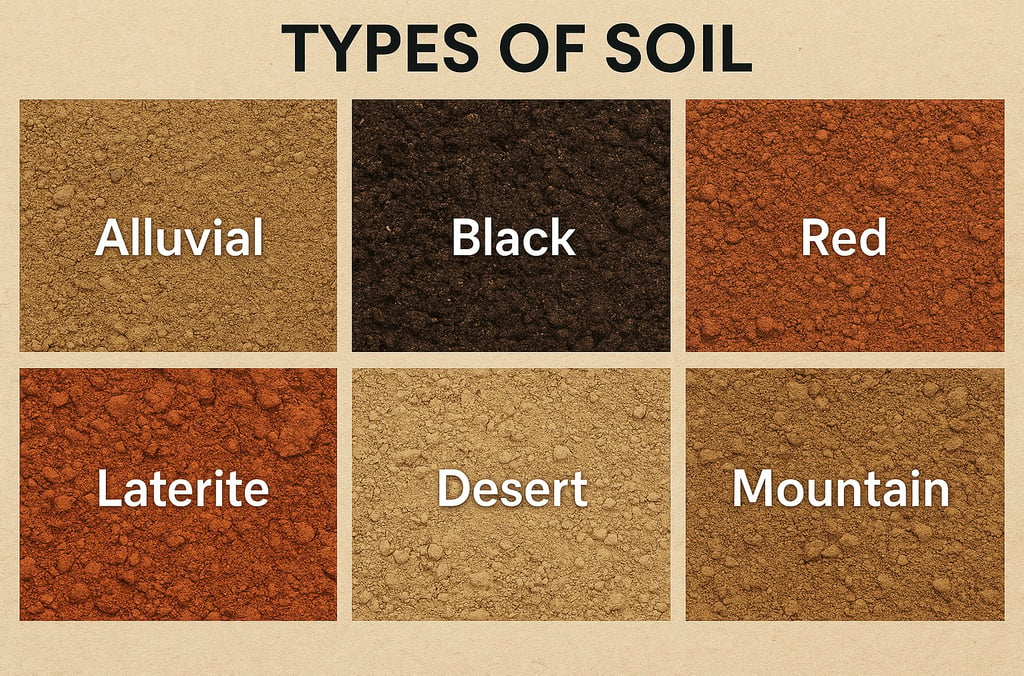Types of Soil: A Comprehensive Guide
Soil is a vital component of the Earth's ecosystem, playing a crucial role in agriculture, construction, and environmental management. Understanding the various types of soil is fundamental for anyone involved in land-related activities, as each soil type possesses unique properties that can significantly influence plant growth and overall ecosystem health.
SOIL HEALTH & FERTILITY
8/29/202510 min read


Introduction to Soil Types
Soil is a vital component of the Earth's ecosystem, playing a crucial role in agriculture, construction, and environmental management. Understanding the various types of soil is fundamental for anyone involved in land-related activities, as each soil type possesses unique properties that can significantly influence plant growth and overall ecosystem health. The composition of soil—including its texture, structure, and mineral content—determines its ability to retain water, supply nutrients, and support the biological activity necessary for thriving plants.
In agricultural contexts, recognizing different soil types is essential for determining the best crops to cultivate in a given area. For example, sandy soils drain quickly and may require more frequent watering, while clay soils retain moisture but can pose challenges for root development due to compaction. Additionally, loamy soils, which are a balanced mix of sand, silt, and clay, are often deemed ideal for farming due to their fertility and effective drainage properties. By understanding soil types, farmers can adopt practices that enhance productivity, improve crop yield, and maintain soil health.
Moreover, the importance of soil types extends beyond agriculture. In construction, knowledge of the local soil composition is critical for ensuring structural stability. Different soil types can significantly affect the foundations of buildings and infrastructure. For example, loose, sandy soils may require specific engineering solutions to prevent settling, whereas clay beds might expand and contract with moisture fluctuations, necessitating careful planning.
Finally, in the realm of environmental management, understanding soil types contributes to effective conservation strategies. Different soils support varied ecosystems, and loss of soil health can lead to negative environmental impacts, such as erosion and diminished biodiversity. Therefore, a comprehensive understanding of soil types serves as the foundation for sustainable practices in agriculture, construction, and environmental stewardship.
Alluvial Soil: The Fertile Deposits
Alluvial soil, recognized for its exceptional fertility, is predominantly found in river valleys and floodplains. This type of soil is formed through the deposition of sediments carried by flowing water, which naturally enriches it with minerals and organic matter during seasonal floods. The accumulation of these materials results in a nutrient-rich composition that is crucial for agricultural practices. The texture of alluvial soil can vary, often featuring a mixture of sand, silt, and clay, allowing for excellent drainage and aeration, making it particularly conducive to growing a diverse range of crops.
The formation of alluvial soil is a dynamic process influenced by the geographical characteristics of the region. Riverbanks, for instance, serve as natural barriers that facilitate sediment accumulation during flood events. As rivers meander, they deposit mineral-laden materials along their courses, leading to the creation of fertile strips that can stretch for miles. This natural process has made alluvial soil highly prized for agriculture, especially in areas where it facilitates the cultivation of food staples like rice, wheat, and various fruits and vegetables.
Geographically, alluvial soil is prevalent in various parts of the world. Major river systems, such as the Nile in Egypt, the Ganges in India, and the Mississippi in the United States, demonstrate the extensive reach of alluvial deposits. These regions have not only supported traditional agriculture for centuries but have also become integral to local economies. The fertile nature of alluvial soil has attracted farmers and agricultural ventures, leading to significant economic output and food security in these areas. Consequently, understanding alluvial soil’s characteristics and distribution is vital for optimizing agricultural practices and addressing food production challenges globally.
Black Soil: The Regur of India
Black soil, commonly referred to as Regur soil, is primarily found in the Deccan Plateau of India. Its distinctive dark color results from the high organic matter content and the mineral richness of the region, creating one of the most fertile soils suited for a variety of agricultural practices. This soil type is characterized by a clayey texture, which contributes to its excellent moisture retention capacity. The ability of black soil to hold water makes it particularly advantageous for cultivating drought-resistant crops, especially cotton, which has earned it the moniker of being the "cotton soil."
The minerals present in black soil are rich in calcium, magnesium, and iron, with a remarkable capacity to naturally fertilize the lands. These nutrients play a vital role in enhancing plant growth, making Regur soil an excellent medium for various crops beyond cotton, such as soybeans, tobacco, and oilseeds. By supporting multiple agricultural activities, black soil sustains the livelihoods of numerous farmers, particularly in the states of Maharashtra, Gujarat, Madhya Pradesh, and Andhra Pradesh.
Crop rotation practices significantly affect the productivity and health of black soil. When different crops are alternated in a season, there is a natural replenishment of nutrients, which enhances soil fertility over time. For instance, rotating cotton with pulses can restore nitrogen levels in the soil, improving overall fertility. However, improper management of this soil type, particularly over-cultivation or monocropping, can lead to soil degradation and nutrient depletion. Therefore, implementing appropriate agricultural strategies is crucial for maintaining the vital qualities of black soil.
Red Soil: The Iron-Rich Wonder
Red soil is characterized by its distinct reddish hue, a result of the high iron oxide content that gives it a unique appearance. This type of soil is primarily formed in regions with hot and dry climates, where weathering processes expose the iron compounds in the parent rock materials. As a consequence of its formation, red soil is often well-drained and can range in texture from sandy to clayey, depending on the local conditions and geological influences.
One of the most noteworthy regions for red soil is Southern and Eastern India, where it covers vast expanses of land. The state of Tamil Nadu, as well as parts of Karnataka and Andhra Pradesh, is notable for its extensive areas of red soil. This soil type has a relatively low nutrient content compared to other soil types, posing challenges for agriculture. Nevertheless, it is notably productive for certain crops, particularly drought-resistant varieties such as millet and groundnut. Farmers in these regions have adapted their practices to work in harmony with the characteristics of red soil, utilizing crop rotation and organic matter to enhance fertility.
In addition to agriculture, red soil plays a vital role in local ecosystems. The soil's distinctive properties influence water retention and drainage, supporting a variety of plant and animal life adapted to these conditions. With careful management, red soil can be effectively utilized to not only provide sustenance but also maintain environmental balance. Understanding the formation, characteristics, and uses of red soil underscores its importance in the broader context of soil science and agricultural practices.
Laterite Soil: The Tropical Soil
Laterite soil is a unique type of soil formation predominantly found in tropical regions characterized by a high degree of weathering and leaching. This particular soil type is rich in iron and aluminum, which imparts a distinctive reddish appearance, making it easily identifiable. The development of laterite soil occurs in areas that experience high annual rainfall, leading to extensive moisture retention and promoting rapid leaching of soluble minerals. As a result, the chemical properties of laterite soil are heavily influenced by the climatic conditions under which it forms.
The physical properties of laterite soil include a coarse texture, which often ranges from sandy to clayey, depending on local conditions. Its structure is typically characterized by a high permeability, allowing for significant drainage. However, this property can present challenges for agricultural purposes, as crops planted in laterite soil may struggle due to nutrient deficiencies. The leaching process prevalent in laterite formations often results in a diminished presence of essential nutrients such as nitrogen, phosphorus, and potassium, which are vital for healthy plant growth. As such, agricultural practices involving this soil type often require the application of fertilizers to replenish nutrient levels.
Despite its challenges, laterite soil serves several important uses. Its high iron content makes it a valuable resource for construction, particularly in regions where other building materials may be scarce. Laterite bricks are commonly used in the construction of homes, schools, and other structures, capitalizing on the soil's durability. Additionally, the unique properties of laterite soil allow it to be utilized in specific horticultural practices where drainage is essential. Understanding the implications of laterite soil on agricultural productivity and its beneficial properties in construction is crucial for optimizing its potential in various applications.
Desert Soil: Adapted for Aridity
Desert soil, commonly found in arid regions, exhibits distinct characteristics that have evolved in response to harsh climatic conditions. These soils typically possess low organic matter, which directly impacts their fertility and viability for supporting diverse plant life. One of the defining features of desert soil is its high salinity, a result of minimal rainfall that leads to the accumulation of salts on the surface. This salinization can pose significant challenges for plant growth, as excessive salt concentrations can hinder water absorption by roots.
Desert soils often have a sandy texture, which allows for quick drainage of water but does not retain moisture effectively. This means that plants living in such conditions have adapted unique survival strategies. For instance, many desert plants, such as cacti and succulents, have developed specialized structures and features that enable them to conserve water. Adaptations may include thick, waxy coatings on leaves, deep-root systems that access groundwater, and the ability to store water in their tissues. These modifications are essential for thriving in environments with limited water availability.
Geographically, significant examples of desert soil can be found in regions such as the Sahara Desert in North Africa, the Arabian Desert in the Middle East, and the Mojave Desert in the United States. Each of these areas showcases variations in soil properties influenced by local climate, vegetation, and human activity. Despite their limitations, desert soils can support specific types of flora and fauna, indicating a rich ecosystem that depends on resilience and adaptation. Understanding the properties of desert soil is crucial for developing effective practices in agriculture and conservation in these extreme environments.
Mountain Soil: The Diverse Ecosystems
Mountain soils are distinctive ecosystems that vary greatly in composition and characteristics due to factors like altitude, climate, and topography. Typically, these soils are a blend of organic material and mineral components, shaped by the unique environmental conditions found at elevated landscapes. As one ascends a mountain, soil characteristics transform, influenced by factors like temperature variations, precipitation patterns, and biological activity, resulting in a remarkable diversity of soil types.
At lower altitudes, mountain soils often demonstrate richer organic matter due to denser vegetation and higher rates of decomposition. As elevation increases, the soil tends to become thinner and less fertile. This trend is partly because of increased erosion, as heavy precipitation can lead to soil movement. Additionally, the colder temperatures and shorter growing seasons at higher altitudes can further limit soil development. Consequently, the fragile nature of mountain soils makes them susceptible to degradation, posing challenges for both ecosystems and agriculture.
The flora and fauna that inhabit these mountainous regions have adapted to thrive in specific soil conditions, relying on the unique nutrients available within their environments. For instance, certain plant species have evolved to utilize the limited resources found in high-altitude soils, while also contributing organic matter through leaf litter and root systems. This intricate relationship illustrates the essential role that mountain soils play in supporting biodiversity. Furthermore, various conservation strategies are being employed to protect these ecosystems, including sustainable land management practices and restoration projects aimed at rehabilitating degraded areas. By recognizing the significance of mountain soils and their ecological function, we can work towards ensuring their resilience and sustainability for future generations.
Loamy Soil:
Loamy soil is often called the “ideal” or “gardeners’ dream” soil because it has a balanced mixture of:
Sand (for good drainage and aeration)
Silt (for fertility and smooth texture)
Clay (for water and nutrient retention)
Key characteristics of loamy soil:
Dark, crumbly, and soft texture
Retains moisture but drains well (no waterlogging)
Rich in nutrients and organic matter
pH usually close to neutral
Supports a wide range of crops
Typical composition:
40% sand
40% silt
20% clay
Best suited crops: Wheat, sugarcane, cotton, pulses, oilseeds, vegetables, fruits, and almost any garden plants.
Saline Soil:
Saline soil is soil that contains high levels of soluble salts, which can make it difficult for most plants to grow.
Key characteristics:
White crust of salt often visible on the surface
Poor water infiltration and drainage
High electrical conductivity (EC), usually >4 dS/m
Causes osmotic stress in plants (roots can’t absorb water easily)
Often found in arid and semi-arid regions
Causes:
Excessive irrigation with salty water
Poor drainage
Natural salt accumulation from parent rock material
Sea water intrusion in coastal areas
Effects on plants:
Stunted growth
Leaf burn or tip drying
Reduced germination
Lower crop yield
Reclamation methods:
Leaching salts with good-quality water
Improving drainage
Applying gypsum (in sodic-saline soils)
Growing salt-tolerant crops (barley, cotton, date palm, etc.)
Sandy Soil:
Sandy soil is soil with a high proportion of sand particles and very little clay or silt.
Key characteristics:
Gritty texture — particles are large and do not stick together
Fast drainage — water passes quickly, so it dries out fast
Low nutrient retention — fertilizers can easily leach away
Lightweight and easy to till
Warms up quickly in spring but cools down quickly at night
Typical composition:
More than 85% sand, very low clay content
Advantages:
Easy to work with for planting and digging
Good for crops that dislike waterlogging (e.g., root vegetables)
Disadvantages:
Needs frequent watering
Requires organic matter to improve fertility
Crops suited for sandy soil:
Groundnut, watermelon, carrot, potato, cucumber, and cashew.
Conclusion: The Importance of Soil Diversity
The exploration of various types of soil reveals their critical contributions to ecological balance and sustainable agriculture. Each soil type possesses distinct physical and chemical properties that determine its capacity to support different ecosystems and crops. For instance, sandy soils, characterized by large particles, facilitate drainage but may lack nutrients, while clay soils, with smaller particles, hold moisture but may present challenges with aeration. Recognizing these differences is paramount for both environmental conservation and effective land use planning.
Soil diversity plays a significant role in maintaining biodiversity. Each soil type supports a unique array of organisms and plant life, contributing to a complex web of interactions that sustain ecological health. Healthy soils are essential for clean water filtration and carbon sequestration, which are vital in mitigating climate change. Moreover, the diversity of soils influences agricultural practices, as specific crops thrive in certain soil conditions. Farmers and land planners must understand these relationships to optimize land use, enhance crop yields, and minimize environmental impact.
Furthermore, the appreciation of soil diversity encourages individuals and communities to adopt sustainable practices. This includes implementing crop rotation, cover cropping, and reduced tillage, all of which protect soil health and improve its resilience. Promoting awareness about soil management practices can lead to more informed decisions that benefit not only the agricultural sector but also the health of our planet. As stewards of the earth, we hold the responsibility to protect and enrich soil diversity, ensuring that future generations inherit a healthy, productive landscape.
















"Boosting Crop Growth With Nature's Power"
Contact Us:
E Mail: support@frosil.com
Customer Care: +91 8329592991
FROSIL © 2025. All rights reserved.


'Frosil' is a fertilizer manufacturer committed to enhancing soil health and crop yields. We provide high-quality, eco-friendly products that support sustainable agriculture and help farmers achieve optimal results.
Registered Office: Gat No.96, Near Krushnai Hospital, Tandali. Tal- Shirur, Dist- Pune.
